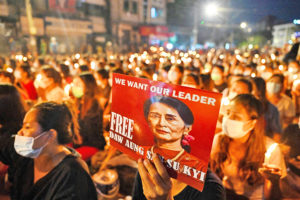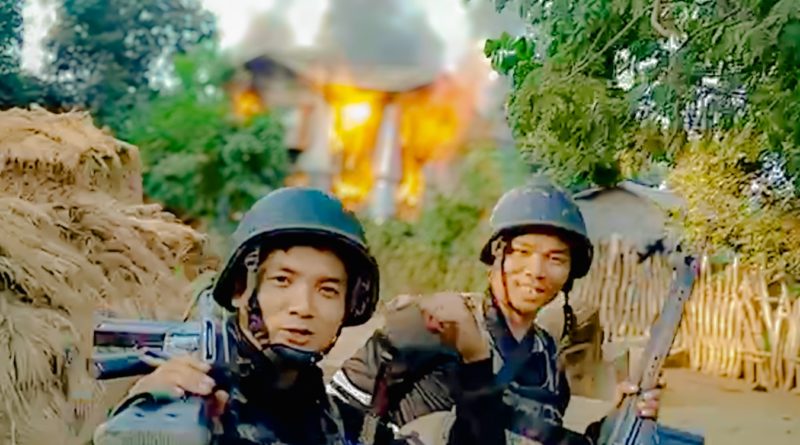ASEANEWS HEADLINE-CIVIL WAR | MYANMAR: In Myanmar’s heartland, a campaign of fire and fury caught on camera
WATC H VIDEO:
Junta troops revel as they watch a house burn to the ground in a village in Magway Region’s Yesagyo Township in late 2023 (Myanmar Now)’
.
.



FREE ASEAN – FREE MYANMAR/CAMBODIA/THAILAND – FREE Aung San Suu Kyi
.

In the early morning of July 28, 2022, villagers living on the western bank of the Chindwin River, one of the three largest rivers in Myanmar, hurried to find a place to hide in the dusty bushes and fields surrounding their village. Clutching their most valuable possessions—gold, cash, mobile phones—they crouched out of sight of the soldiers they had heard were coming. Those too old or infirm to flee stayed behind, resigned to their fate.
The residents of Yey-khar, a village of more than 200 households in Sagaing Region’s Salingyi Township, had received word that a column of junta troops was approaching. By this time, more than a year and a half had passed since the military seized power, igniting a fight to the death between the regime and the resistance, and everyone knew that rumours of soldiers on the rampage had to be taken seriously.
The column of around 80 men—20 soldiers and the rest a mix of plainclothes police and members of a military-organised militia—arrived at around 7am. They were armed with Myanmar-made MA4 assault rifles, machine guns, and grenade launchers.
Finding the village largely deserted, one soldier started shouting abuse as he kicked the clay pots and other household items he found in the first thatch-roofed, bamboo house he entered.
“F**k the public. F**k the PDF. You are supporting the PDF. Anyone who supports the PDF, come out. Anyone who dares to die, come out,” he yelled, referring to the People’s Defence Force resistance groups formed to oppose the dictatorship of 68-year-old coup leader Senior-General Min Aung Hlaing.
Unaware that his actions were being secretly recorded by two villagers hiding nearby, the soldier pointed his rifle skyward and fired two shots. The sound dissipated quickly in the eerie silence.
Then, in a video obtained by Myanmar Now, he can be seen taking out a pocket lighter and setting fire to the eaves of the house, its roof made from the toddy palm leaves so often used by residents of Myanmar’s arid central plains to cover their homes.
As smoke rose from the burning leaves, the soldier ignited the roof in a few more places, ensuring that the flames would spread to the whole house. In total, 87 homes were reduced to ashes in the village that day, including some two-storied wooden structures.
The two villagers who recorded this scene managed to escape with this evidence of the military’s arson attacks on their homes. Two other residents who were taken hostage by the soldiers were not so lucky.
Yey-khar had attracted the military’s attention because a few months after the 2021 coup, residents opposed to the newly installed regime killed its junta-appointed administrator and his son in an early act of resistance. This incident spread panic among other ward and village administrators in the township, leading to mass resignations.
But Yey-khar is far from unique. Across much of Myanmar’s rural heartland, the military has resorted to relentless attacks on civilians in an effort to terrorise local people into submission. Using both airstrikes and on-the-ground raids, it has extended its notorious “four cuts” strategy—long used to deprive ethnic armed groups of recruits, funding, food supplies, and intelligence—to areas once firmly under its control.

What makes this particular incident remarkable is that it is one of the rare instances of regime forces being caught on camera as they commit their crimes against the civilian population. Together with the testimony of witnesses, it offers irrefutable evidence of the junta’s deliberate destruction of entire villages.
The order to burn
Aung Soe Min was one of the two men taken hostage that day. An impoverished shepherd, he had fled with his wife and daughter to the woods near Yey-khar, but panicked when he saw a plume of smoke rising from the village. Desperate to save his small flock of sheep, he returned to his farm, only to be captured by soldiers.
While he was still in the village, he saw a number of soldiers going from house to house, lighting fires. As they were doing this, an improvised explosive device set by a local resistance group went off. Enraged, their commanding officer ordered them to intensify their efforts.
“Not a single house should be left standing,” the officer shouted.

The soldiers completed their task and then left, taking Aung Soe Min and another man named Aung Thein with them. Once they were far enough away, the hiding villagers, some armed with swords or handmade rifles, returned to try to put out the flames, even though most of the damage had already been done. They also rescued the elderly people who had been unable to flee; fortunately, none had been killed. Cattle and sheep were also released from their pens.
But Aung Soe Min’s ordeal had only just begun. He and the other man were forced to carry looted goods from Yey-khar to a nearby agriculture department office now being used as a sort of local military command centre. He was detained there for the next two weeks, locked up in a room with other men captured during previous raids for use as human shields.
“I wasn’t beaten on my way from the village to the agriculture department office, or while I was in custody. But a soldier threatened me, pointing a knife at me and saying, ‘Shall I cut your throat?’ My hands were tied. I was panicking,” he said in a telephone interview with Myanmar Now.
He also recalled being taunted by a policeman who tried to provoke him by using a derogatory term to refer to Aung San Suu Kyi, Myanmar’s deposed civilian leader. The police officer suggested that things would have been different if the country had been ruled by Aung San Oo, Suu Kyi’s elder brother, instead of her. His remarks reflected the deep-seated misogyny and distrust of liberal democracy instilled in many regime officials through decades of military propaganda.

But the worst part of his time in junta detention, he said, was witnessing the murder of two other detainees—one shot dead by a soldier who wasn’t satisfied with something he had been told to do, and the other kicked to death by an angry guard. Both incidents were later confirmed by other prisoners and by an army deserter.
When he returned to Yey-khar following his release, Aung Soe Min found that his house and everything he owned had been destroyed. Like hundreds of his fellow villagers, he had been left homeless and penniless, forced to rely on food handouts from residents of neighbouring villages.
Paw San, one of the village’s more prosperous residents, was similarly reduced to poverty. Her teak-wood house, which had been her family’s home for generations, was destroyed, and she also lost her cattle and crops, the source of their modest prosperity. Even her water pump—an absolute necessity in this region—was damaged beyond repair.
“When we ran, my only thought was getting my elderly mother out of there. I didn’t look back even when I lost my slippers. When I returned to the village, I was afraid to even check my house, fearing I might have a heart attack. When I finally did, I found nothing there was nothing left of it but barren land blackened with ash,” she said.

The marauding column
The column that attacked Yey-khar consisted of troops from Light Infantry Battalion (LIB) 369 and LIB 704, both operating under the Northwestern Regional Military Command, based in Sagaing Region’s capital, Monywa. At the time, LIB 369 was commanded by Colonel Than Naing Oo and LIB 704 by Major Min Lwin Oo.
Corporal Htin Aung Kyaw, a retired serviceman who was called back to active duty after the coup, was one of the LIB 369 troops who took part in the attack on Yey-khar. After defecting to the resistance, he admitted to torching at least five homes in the village.
In an interview with Myanmar Now, he explained the military’s rationale for inflicting such immense hardships on civilians living in conflict zones.
“The army believes that burning down people’s properties and houses will prevent them from supporting the PDF, and that the PDF will not survive without this support. With this intention, they set fire to villages and shoot those who resist,” he said.

Htin Aung Kyaw had spent 15 years in the military before his retirement in 2012. At the time, Myanmar appeared to be emerging from decades of brutal military rule. He did not imagine that a decade later, he would be back in the field, fighting for the survival of yet another ruthless regime.
Initially, he was assigned to a security checkpoint in Sagaing’s Homalin Township. But as armed resistance to the junta gained momentum, his unit was ordered to conduct raids on villages in Sagaing and Magway regions suspected of harbouring anti-regime elements.
In the case of Yey-khar, these suspicions were not unfounded. Sixty men from the village had left for areas controlled by ethnic armed groups to receive military training and later returned to fight the junta’s forces. One of them was Mae Gyi, a 32-year-old farmer and handyman who joined “Tiger with Stripes”—one of many guerilla groups that have emerged around the country since the coup.
In the past, Mae Gyi’s days revolved around doing whatever he had to do to make a living, including climbing toddy palm trees to tap their sap. But when Min Aung Hlaing seized power after refusing to recognise the results of the November 2020 elections—something his predecessors had done 30 years earlier, also in denial of a landslide victory by Aung San Suu Kyi’s National League for Democracy—his life changed forever.

Outraged by the coup and the regime’s violent crackdown on protests, he resolved to fight against a return to military rule. As someone who had grown up under an earlier dictatorship, he knew what to expect if the military prevailed again this time.
“During the previous military era, we always had to deal with forced labour. While we were struggling to earn a living, we were ordered to volunteer in state development programs such as dam construction. My parents suffered a lot,” he told Myanmar Now.
“That’s why I joined the armed resistance movement,” he said.
By mid-2023, 14 of Sagaing Region’s 37 townships had been placed under martial law because of people like Mae Gyi. This is a stunning development in a region that was once the military’s most reliable source of new recruits.
And despite the regime’s scorched-earth campaigns, airstrikes, and deployment of “ogre columns”—special units of marauding soldiers sent to instil terror in the public through acts of extreme violence—the resistance movement in Sagaing has shown no signs of weakening. Taking advantage of the region’s vast rural and mountainous terrain, its forces have not only managed to survive, but also to regroup and continue to expand their networks.

Further evidence
For its part, the military has always acted as if its ultimate success in bringing the country under its full control was a foregone conclusion. This confidence can be seen in some other videos that have emerged, shot by junta soldiers themselves, that show their certainty that they would never have to face any consequences for their actions.
In one clip, a group of soldiers and police, some of them in plainclothes, can be seen revelling in their absolute impunity as they watch a house burn to the ground in a village in Magway Region’s Yesagyo Township late last year.
“This is the Tatmadaw!” shouts one of the junta troops, referring to Myanmar’s military by its formal name, as another laughs and waves at the camera. “Take a look at your PDF house,” he adds, as the flames crackle in the background. Other soldiers can also be seen standing around, staring at the fire or helping themselves to some clothes picked off a rack.
This video, which Myanmar Now has traced back to an arson attack on October 19, 2023, was found on the phone of a woman who was detained by anti-regime forces after it was learned that her husband was a police officer involved in attacks on civilians.
Another video on the same phone shows a soldier singing happily after setting fire to some houses. Others feature soldiers opening fire on another village in the same township.
]Two other videos shot by a junta soldier—and found on his phone after he had been killed in a clash with resistance forces—capture similar scenes. The videos, which are 2.5 minutes and 46 seconds in length, were taken in May of this year in a village about 10 miles south of the town of Yesagyo.
The first shows soldiers firing indiscriminately as they enter the village and force their way into locked houses. One soldier can be heard cursing after breaking into a house and finding nothing of value inside. “Worthless house!” he shouts, before noticing other prospective targets of his looting spree. “There are more over there,” he says, as he and his comrades continue their rampage.
The second video was taken during their departure from the village. “We just burned down a PDF village. We are Tatmadaw soldiers! Those motherf**kers’ village is now burned to ashes,” shouts a soldier, as the camera captures scenes of the inferno they left in their wake.
At least six soldiers can be clearly seen in the videos. By closely examining certain details, including markings on the soldiers’ rifles, and corroborating its findings with local civilians and armed resistance groups, Myanmar Now was able to determine that the soldiers belonged to Yesagyo-based LIB 257, which operates under the command of Light Infantry Division 101, based in Magway’s Pakokku Township.

Changing dynamics
While these scenes reveal the cruelty of a regime determined to cling to power at any cost, they also demonstrate the high price that civilians have paid for the guerrilla tactics employed by the resistance, which have included ambushes on junta convoys and the targeted assassination of regime officials. As reprisal for these attacks, the military has burned down hundreds of villages in central Myanmar, leaving hundreds of thousands homeless.
More recently, however, the junta has faced a very different challenge, as PDF groups increasingly adopt the approach taken by ethnic armies that have been waging a major offensive against the regime since late last year.

Across northern Shan State and Rakhine State, these ethnic armed groups have overrun scores of junta bases and outposts and captured dozens of towns, culminating in the fall of Lashio, northern Shan State’s largest city, earlier this month. That devastating defeat, which also saw the regime lose control of the headquarters of its Northeastern Regional Military Command, has left the military in an increasingly precarious position.
One effect of this has been a reduction in the number of raids and airstrikes carried out in other areas. Another has been a growing willingness on the part of PDF groups to take the fight directly to the junta, as they have been doing, most notably, in Mandalay Region, where they have captured two towns since launching a new offensive in late June.

“We don’t want to use guerrilla tactics anymore. If we target a junta column passing by a village, the obvious result is the villagers will be butchered, and the village will be burned down. It’s not worth it if we reflect on what we did,” said the spokesperson for a PDF group in Mandalay Region.
“We’d rather rely on conventional warfare from now on, to try to occupy a military base or a whole town. The military is on the defensive now, and we are on the offensive,” he added.
Written by Swe Win, Maung Shwe Wah and Sa Tun Aung


 Memento Maxima Digital Marketing
Memento Maxima Digital Marketing








